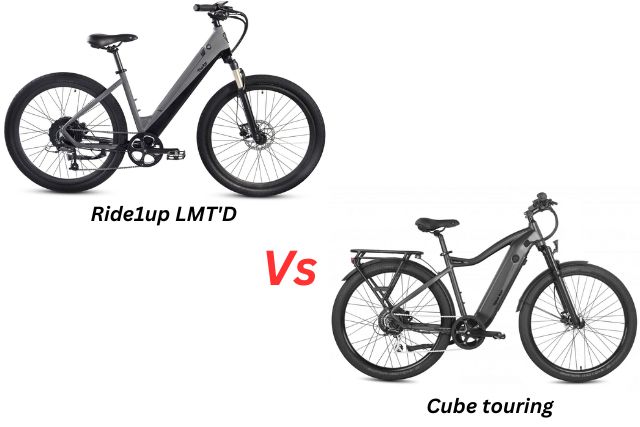
If you are looking for a powerful and comfortable e-bike that can handle both urban and light off-road riding, you might be interested in comparing two popular models from Ride1UP: the LMT’D and the 700 Series.
These two e-bikes have a lot in common, but they also have some significant differences that could affect your decision.
We will review the main features, specs, pros and cons of each model and help you decide which one is right for you.
Head-to-Head Comparison: LMT’D vs. 700 Series Class 3 E-Bikes
The LMT’D and the 700 Series are both class 3 e-bikes, meaning they can reach speeds of up to 28 mph with pedal assist. They have 750W hub motors, but the LMT’D has a higher torque of 100 Nm, compared to 60 Nm for the 700 Series.
The LMT’D has more power to climb hills and accelerate faster. However, this means that the LMT’D consumes more battery power and has a slightly lower range of 30-50 miles, compared to 35-55 miles for the 700 Series.
Battery
Both e-bikes have 48V batteries with Samsung cells, but the LMT’D has a higher capacity of 672 Wh, compared to 624 Wh for the 700 Series.
The batteries are integrated into the downtube of the frames, giving both models a sleek and modern look. The frames are made of aluminum alloy and come in two versions: step-through (ST) and step-over (XR).
The ST version is more accessible and comfortable for riders with limited mobility or who prefer an upright riding position. The XR version is more sporty and aggressive, suitable for riders who like a more dynamic riding style.
Related: Ride1up Cafe Cruiser vs. 700: Detailed Comparison
Suspension
The LMT’D and the 700 Series have different suspension systems that affect their performance and comfort on different terrains.
LMT’D
The LMT’D has an air suspension fork with 100 mm of travel and lockout function, which allows you to adjust the stiffness and responsiveness of the fork according to your preference and riding conditions.
700
The 700 Series has a coil suspension fork with 80 mm of travel and preload adjustment, which lets you change the spring tension of the fork to match your weight and riding style.
Tires
The tires are another important factor to consider when comparing these two e-bikes.
The LMT’D has WTB Horizon tires that are 27.5″ x 2.0″, which are narrower and smoother than the Chaoyang Sandstorm tires that are 26″ x 3.0″ on the 700 Series.
The WTB tires are more efficient and suitable for paved roads and light gravel trails, while the Chaoyang tires are more grippy and stable on rough terrain and sand.
Related: Ride1up Prodigy vs. 700: A Comprehensive Comparison
Technical Specifications: LMT’D and 700
The LMT’D and the 700 Series have similar drivetrains, brakes, displays, lights, throttles, and pedal assist systems.
They have Shimano Acera derailleurs with 8-speed cassettes, Zoom hydraulic disc brakes with motor cutoff sensors, KD21C LCD displays with speedometer, odometer, battery level indicator, assist level indicator, etc., front LED lights powered by the main battery, left thumb throttles that can reach up to 20 mph without pedaling, and cadence sensors that provide five levels of pedal assist up to 28 mph.
Distinctive Features of LMT’D E-Bike
There are some minor differences between these components as well.
The LMT’D has a torque sensor instead of a cadence sensor, which means that it measures how hard you pedal instead of how fast you pedal. This gives you a more natural and responsive feeling when riding with pedal assist, as the motor adjusts its power output according to your pedaling force.
It has dual-piston brakes instead of single-piston brakes, which provide more stopping power and modulation.
Accessories and Add-ons: LMT’D vs. 700
One downside of the LMT’D is that it does not come with any accessories, such as fenders, rear rack, or taillight. These are optional add-ons that you can purchase separately from Ride1UP or other sources.
The 700 Series comes with metal alloy fenders, a rear rack that can support up to 130 lbs of cargo or passengers (with an optional passenger kit), and a Velo Edge taillight that is integrated into the saddle.
Related: How to Reduce The Weight of an E-Bike?
Price
The LMT’D and the 700 Series have different price tags as well.
The LMT’D costs $1,695 USD (as of July 2023), while the 700 Series costs $1,595 USD. This is a $100 difference that could be worth it if you value the extra power, torque, battery capacity, air suspension, and torque sensor of the LMT’D.
If you prefer the wider tires, coil suspension, and included accessories of the 700 Series, you might save some money and still get a great e-bike.
Conclusion
The LMT’D and the 700 Series are both excellent e-bikes that offer a lot of value for their price.
They are both suitable for urban and light off-road riding, but they have different strengths and weaknesses that could appeal to different types of riders.
The LMT’D is more powerful, responsive, and efficient, while the 700 Series is more stable, comfortable, and accessorized.
Ultimately, the choice depends on your personal preference and riding needs.
